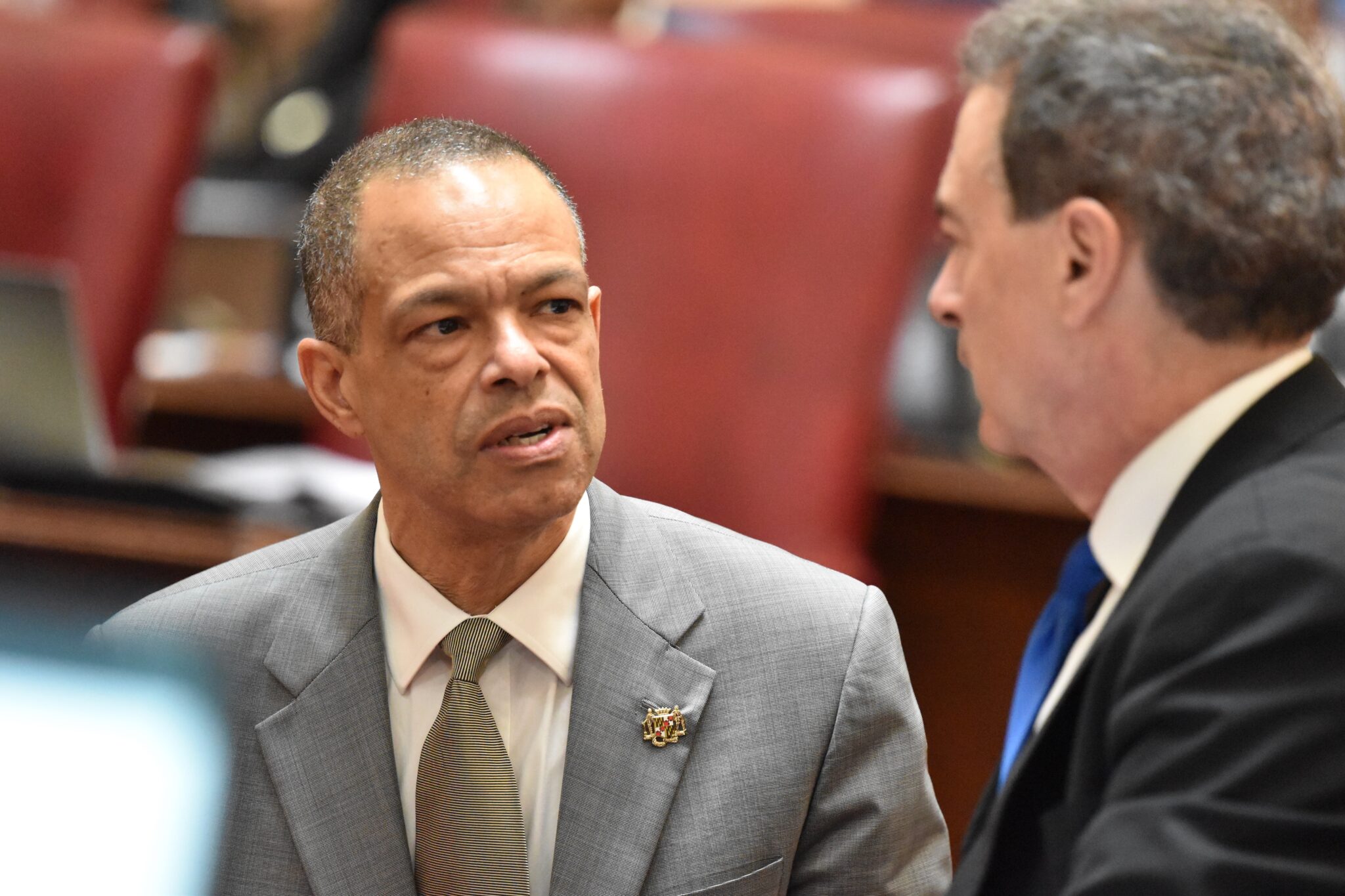


by Christine Condon, Maryland Matters
The Maryland Senate Tuesday passed a package of energy reform bills that would set in motion a variety of electricity generation projects — from solar to nuclear to natural gas — start long-term energy-supply planning efforts and give ratepayers a slight rebate.
The goal, legislators say, is to eventually tamp down skyrocketing electric costs with a host of policy prescriptions — and also give residential ratepayers, on average, an $80 refund on their electric bills in the next fiscal year.
“What we know is that every dollar matters,” said Senate President Bill Ferguson (D-Baltimore City), “and so we are doing what we have immediately available of ratepayer money and returning it to ratepayers in the most efficient way that we can, while focusing on the longer term, complex problem of increasing generation, and making it cleaner.”
The bills backed by legislative leaders passed the chamber virtually untouched, but collectively garnered nearly three hours of debate. They now move to the House for consideration, with Monday’s end to the legislative session looming.
Ferguson said Tuesday that leaders in the two chambers are closely aligned on the bills.
“It’s hard conversations, because these are really complex topics, and I think that we’ve really gotten to a good spot of general agreement,” Ferguson said. “There are going to be changes here and there, things around multiyear rate plans. I think we’re going to be OK.”
Four Republican senators voted in favor of the broadest bill of the bunch, the Next Generation Energy Act, which included the ratepayer reimbursement, “fast track” proceedings for new power generation facilities and an end to a controversial subsidy for trash incinerators that create energy.
Sen. Justin D. Ready (R-Carroll and Frederick), the chamber’s minority whip, said he’d be voting against the bill, in part because he felt it should have done more to repay ratepayers for what he called the state’s flawed renewable energy policy. He argued the bill should have included further incentives for natural gas power plants, calling the fuel “nature’s gift.”
But, speaking on the Senate floor Tuesday evening, Ready said there were redeeming parts of the bill.
“My vote is going to be red. I think there could be some members of my caucus that vote green, and that’s a fine vote too,” Ready said.
Attracting significant debate Tuesday was a bill to create uniform standards for solar projects in Maryland, including requirements that they be fenced off, set back from nearby buildings and surrounded by trees and shrubs.
The bill came in response to concerns that Maryland’s patchwork of varying local regulations on solar were pushing solar developers away, said Sen. Brian J. Feldman (D-Montgomery), chairman of the Senate’s Education, Energy and the Environment Committee.
“We’re retiring oil and coal plants, so we are in a bit of a pickle,” Feldman said. “If we let every local commissioner group or city council have veto authority about any energy project anywhere in the state we’re going to have even a bigger problem.”
Currently, the Maryland Public Service Commission has final say on all solar projects that generate 2 megawatts or more of electricity. In other words, the state commission, which regulates utilities, can overrule local authorities to approve a solar project in a community.
But Feldman said the bill would do something “unprecedented” to limit the commission’s broad authority: It would limit solar generating stations to 5% of “priority preservation areas” in the state, which are lands capable of supporting agricultural or forestry operations.
Republican senators expressed concerns about preserving the character of rural areas and ensuring fields aren’t permanently lost to solar panels. In turn, they made several attempts to lower the 5% cap, but their efforts failed to win Democratic support.
“We’re talking about utility-scale solar that is eating up much of agricultural fields and lands in especially the Eastern Shore of Maryland,” said Sen. Steve Hershey (R-Upper Shore), the minority leader.
An attempt by Sen. Johnny Mautz (R-Middle Shore) to lower the cap to 2% failed, as did Hershey’s proposal to start the cap at 2% before later raising it to 5% — so long as solar arrays were spread equally around the state.
“This is a very simple amendment. It’s reasonable … It just says it has to be done equally around the state,” Mautz said. “We just want to be treated fairly. That’s all we want.”
Republican senators also took issue with pieces of the broader energy bill proposed by leadership, the Next Generation Energy Act, although they generally agreed with the premise that the state needs more in-state energy supply to reduce consumer costs and the state’s reliance on large transmission lines.
When it came to light last year, a new power transmission line expected to cut through rural portions of Baltimore, Carroll and Frederick counties drew considerable community pushback. The proposed Maryland Piedmont Reliability Project was necessitated in part by the retirement of Maryland coal-fired poewer plants Brandon Shores and H.A. Wagner, as well as an increase in energy demand, including from power-hungry data centers in Northern Virginia.
In one amendment, Maryland Republicans proposed sending more direct relief to residential ratepayers than the expected $80 in fiscal 2026.
The bill brought to the floor Tuesday would pull a one-time chunk from the Strategic Energy Investment Fund, which utilities pay into when they fail to comply with a state law that requires them to pay for a certain amount of renewable energy.
Hershey’s attempt to make consumer payments permanent failed.
“We’re getting a lot of phone calls and emails. It’s not because somebody’s bill went up $40, but it went up multiple hundreds of dollars,” Hershey said.
Hershey also tried to add language limiting multiyear rate plans for utilities, which let power companies propose several years of rate increases in a row. The bill that reached the Senate floor Tuesday would prevent multiyear rate plans unless they show a benefit to ratepayers.
Hershey suggested eliminating the mutliyear plans altogether, arguing that the state should return to “traditional” year-by-year ratemaking. But Democrats disagreed, arguing that multiyear ratemaking could allow utilities to save customers money by planning ahead for costs.
“If they are able to use it in the right way, we want this tool to be on the table,” said Sen. Malcolm Augustine (D-Prince George’s). “Now, what we are not going to allow is for them to then just use this as a piggy bank.”
Republicans also saw an opening to try and amend the state’s Renewable Portfolio Standard, which requires utilities to meet a minimum percentage of their electricity sales with renewable energy sources, for which they purchase credits from generators of approved renewable energy.
The bill removes trash incinerators, also known as waste-to-energy facilities, from the list. They were added to the list in 2011.
Hershey argued the Senate should lower the required renewable energy percentage by 15% — approximately the amount that incinerators contributed as of the most recent report. But Augustine disagreed, arguing that renewable energy projects coming online in the future would “fill this gap.”
“The committee made a policy decision that the state of Maryland no longer felt that waste-to-energy was an appropriate part of the renewable energy portfolio,” Augustine said.
Maryland Matters is part of States Newsroom, a nonprofit news network supported by grants and a coalition of donors as a 501c(3) public charity. Maryland Matters maintains editorial independence. Contact Editor Steve Crane for questions: [email protected].
Source link

